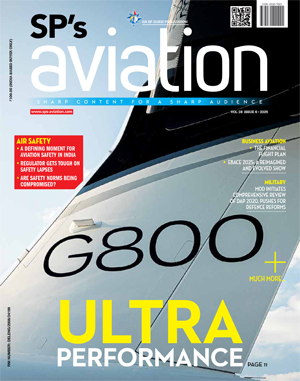INDIAN ARMED FORCES CHIEFS ON OUR RELENTLESS AND FOCUSED PUBLISHING EFFORTS

The insightful articles, inspiring narrations and analytical perspectives presented by the Editorial Team, establish an alluring connect with the reader. My compliments and best wishes to SP Guide Publications.

"Over the past 60 years, the growth of SP Guide Publications has mirrored the rising stature of Indian Navy. Its well-researched and informative magazines on Defence and Aerospace sector have served to shape an educated opinion of our military personnel, policy makers and the public alike. I wish SP's Publication team continued success, fair winds and following seas in all future endeavour!"

Since, its inception in 1964, SP Guide Publications has consistently demonstrated commitment to high-quality journalism in the aerospace and defence sectors, earning a well-deserved reputation as Asia's largest media house in this domain. I wish SP Guide Publications continued success in its pursuit of excellence.
- Prime Minister Modi Visits Punjab’s Adampur Air Base, Interacts with Airmen after Successful ‘Operation Sindoor’; Stern Message to Pakistan
- The layered Air Defence systems that worked superbly, the key element of Operation Sindoor
- Operation Sindoor | Day 2 DGMOs Briefing
- Operation Sindoor: Resolute yet Restrained
- India's Operation Sindoor Sends a Clear Message to Terror and the World – ‘ZERO TOLERANCE’
- Japan and India set forth a defence cooperation consultancy framework, talks on tank and jet engines
RTX's Pratt & Whitney collaborates with FAA to study non-CO2 emissions under FAA ASCENT program
Tests will compare emissions from conventional Jet A and 100 per cent SAF

Pratt & Whitney, an RTX business and the Federal Aviation Administration (FAA) will work together with Missouri University of Science and Technology (Missouri S&T), Aerodyne Research, Inc., and the Environmental Protection Agency (EPA) to study non- CO2 aviation emissions, to help understand and reduce the environmental impact of those emissions. As part of the FAA's ASCENT program, the project will measure emissions from a Pratt & Whitney GTF™ engine combustor rig test stand using conventional Jet A and 100 per cent sustainable aviation fuel (SAF).
"As the aviation industry targets a goal of net-zero CO2 emissions by 2050, we continue to pay close attention to addressing the environmental impact of other emissions, including cruise non-volatile particulate matter and NOx," said Sean Bradshaw, senior technical fellow of sustainable propulsion at Pratt & Whitney. "Combustor rig tests with 100 per cent SAF provide a controlled environment for generating valuable baseline data, which will support future studies using full scale engines on-wing at ground and flight test conditions."
The project will compare emissions from Jet A kerosene and SAF comprised of 100 per cent Hydroprocessed Esters and Fatty Acids Synthetic Paraffinic Kerosene (HEFA-SPK), a biofuel derived from vegetable oils and animal fats; the fuel is supplied by World Energy.
"By bringing together expertise from industry, government, and academia, this project represents an important step towards understanding and reducing the environmental impacts of aviation, including those arising from non-CO2 emissions," said Dr. Philip Whitefield of Missouri University of Science and Technology. "SAF containing low sulfur and aromatic hydrocarbon concentrations could contribute to reduced sulfur dioxide and non-volatile particulate emissions, which are associated with contrail formation and the impact to global warming."
The rig tests will take place at Pratt & Whitney's facility in Middletown, Conn., using an advanced Rich-Quench-Lean (RQL) combustor. The rig allows testing of the full range of combustor operating conditions, including at take-off, ground, and cruise altitudes, to help understand the environmental and emissions benefits of using SAF. Pratt & Whitney, the FAA, Missouri S&T, Aerodyne Research, and the EPA will collaborate on test design, execution, and emissions data analysis.





